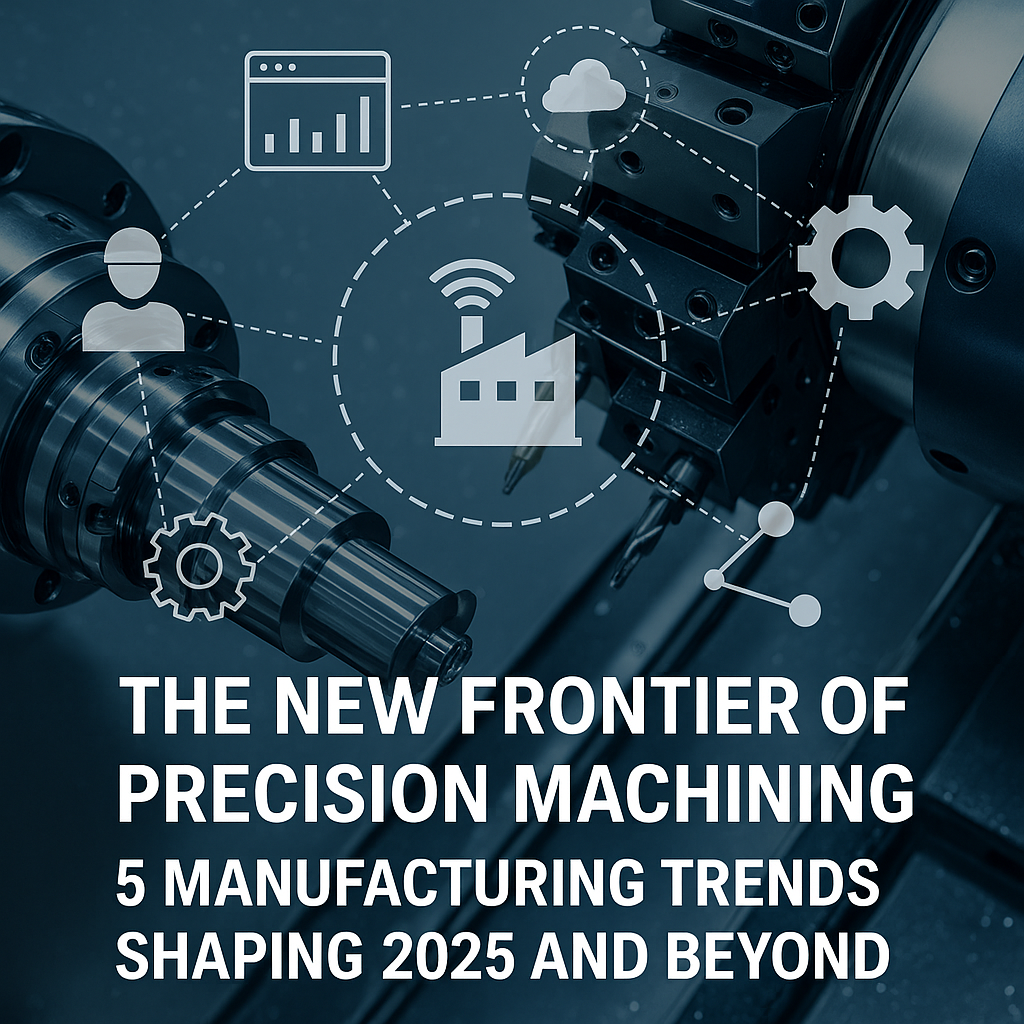In the world of precision CNC machining, staying ahead isn’t just about tighter tolerances or faster spindle speeds. The industry is evolving at a rapid pace, and the most successful machine shops of tomorrow will be those that adapt to—and drive—these shifts. Below are five major trends transforming manufacturing today, and how Fairchild is positioning itself as a forward-leaning partner in this changing landscape.
1. Smart Factories Go Mainstream (Not Just a Buzzword)
We’ve long heard about Industry 4.0 and the promise of “lights-out” factories. But in 2025, that promise is turning into practical deployment. According to Deloitte’s 2025 Smart Manufacturing Survey, companies that adopt integrated sensor networks, advanced analytics, and real-time control systems are seeing gains in agility, throughput, and quality.
What this means for turned parts suppliers:
-
Machine tools outfitted with embedded sensors now monitor vibration, thermal drift, tool condition, and lubrication health in real time.
-
Data from CNC operations, material feeds, and in-process inspection is converged into central dashboards for line-of-sight visibility.
-
Predictive maintenance (rather than reactive fixes) is becoming table stakes, helping reduce unplanned downtime and parts scrap.
At Fairchild, our forward investment in sensor integration and digital manufacturing infrastructure means we partner with customers who demand not just parts—but predictable, optimized supply.
2. AI, Agentic Systems & Data-Driven Automation
While automation has been creeping into machining for decades, the newest wave centers on intelligent, self-learning systems. These systems (sometimes called agentic AI) can dynamically adjust planning, scheduling, and even toolpath decisions without human intervention.
Highlights of this shift:
-
AI-enhanced process optimization: Algorithms fine-tune cutting feeds, speeds, and tool selection in response to small deviations or condition changes.
-
Autonomous scheduling: Systems can re-sequence jobs on the fly in response to delays elsewhere in the supply chain.
-
Closed-loop feedback: Inspection data can feed back into process corrections automatically, reducing reliance on manual calibration.
For Fairchild, this means faster ramp to stable process, tighter control on yields, and the ability to respond to changes (material lots, thermal shifts, etc.) with agility.
3. Resilient, Local Supply Chains & Onshoring
Recent supply chain disruptions have exposed the fragility of long, globalized sourcing networks. As a result:
-
Many manufacturers are rethinking where they source components, favoring reshoring or nearshoring to improve responsiveness and reduce lead-time variability.
-
The “right-shore” balance—mixing global and regional sourcing for optimal resilience—is gaining traction.
-
Incentive policies and procurement preferences (especially in aerospace, defense, and governmental supply chains) increasingly reward domestic capability.
Fairchild’s location in the U.S. Eastcost corridor gives us a strategic advantage. We can offer shorter transit times, greater supply continuity, and lower risk compared to long-haul overseas alternatives.
4. Sustainability, Circular Economy & Energy Efficiency
Manufacturers are under growing pressure—from clients, regulators, and the public—to reduce carbon footprints and move toward circular practices.
Key areas of focus:
-
Energy-efficient machining: Optimizing toolpaths, regenerative drives, better cooling systems, and machine idling strategies.
-
Material recycling and reuse: Using remelted or requalified raw stock, reclaiming scrap chips, and reducing waste stream.
-
Lifecycle thinking: Designing processes with downstream remanufacturing, rework, or end-of-life reuse in mind.
Sustainable practices don’t just protect the environment—they also reduce waste, improve margins, and open doors to OEMs that require ESG alignment.
5. Workforce Evolution: Upskilling, Hybrid Roles & Digital Literacy
Even as automation and AI accelerate, people remain central to success. But the nature of their roles is changing:
-
Machinists increasingly need data literacy: interpreting dashboards, validating analytics, and supervising AI-driven decisions.
-
Hybrid roles: operator + data analyst + process engineer roles are emerging as the new standard.
-
Upskilling & apprenticeship: Continuous training in digital tools, predictive analytics, AI systems, and quality technologies is now essential.
Fairchild invests in cross-training and learning culture to ensure our people are not replaced by machines—but empowered by them.
Why These Trends Matter to You (Our Customer)
As an engineer, buyer, or supply chain leader, your concern isn’t novelty—it’s risk, reliability, and results. These trends matter because they shift the basis of competition:
-
Predictability: Leading-edge systems reduce variation and improve first-pass yield.
-
Responsiveness: Nearer sourcing and smarter automation let you pivot faster in changing markets.
-
Partnership value: Your vendor must do more than “turn parts.” They need to mitigate supply risk, continuously improve, and co-invest in capacity.
-
Future compatibility: As your own designs integrate sensors, smart systems, or connected products, your parts supplier must speak the same digital language.
At Fairchild, we see ourselves not just as an order-taker but as a strategic partner. Our investments in digital transformation, process intelligence, sustainability, and workforce development let us serve customers who demand more than just dimensions.
What Fairchild Is Doing Right Now
-
Integrating edge data from machines into a unified MES for real-time insights
-
Piloting feedback loops where inspection data refines process parameters automatically
-
Establishing scrap recovery and chip recycling programs
-
Encouraging cross-disciplinary upskilling (CNC + data + quality)
-
Optimizing energy usage across facility systems, HVAC, and machine cycles
We believe the future of precision machining is smart, ethical, responsive—and that we’re uniquely positioned to deliver it.
If you’re evaluating a new turned-parts partner—especially one that needs to scale, pivot fast, or support connected-product strategies—let’s talk. Request a quote or conversation, and we’ll show you what differentiates a “legacy supplier” from a partner engineered for tomorrow.

